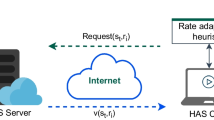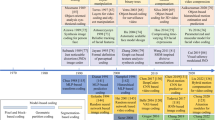Abstract
The scalable extension of the H.264 Advanced Video Coding (AVC) standard called Scalable Video Coding (SVC), or H.264/SVC, provides scalable video streams which are composed by a base layer and one or more enhancement layers. Enhancement layers may improve the temporal, the spatial or the signal-to-noise ratio resolutions of the content represented by the lower layers. One of the applications of this video coding standard is related to point-to-multipoint video distributions in both wired and wireless communication systems, where packet losses contribute to the degradation of the user’s Quality of Experience. Designed for the transmission of data over Binary Erasure Channels (BEC), Raptor codes are a Forward Error Correction (FEC) mechanism that is gaining popularity for Internet Protocol Television (IPTV) applications due to their small decoding complexity and reduced overhead. This paper evaluates the quality enhancements introduced by the integration of several H.264/SVC layers with a Raptor coding protection scheme. Our goal is to improve the distribution of video over loss prone networks in terms of rate-distortion performance by assessing several alternative packetization options and protection schemes.
Similar content being viewed by others
References
Shokrollahi, A. (2006). Raptor codes. IEEE Transactions on Information Theory, 52(6), 2551–2567.
Elias, P. (1955). Coding for two noisy channels. In Proc. 3rd London symp. on information theory, London, UK, pp. 61–76.
Advanced Video Coding for Generic Audiovisual Services (2007). ITU-T Rec. H.264 and ISO/IEC 14496-10 (MPEG-4 AVC), ITU-T and ISO/IEC JTC 1, Version 1: May 2003, Version 2: May 2004, Version 3: March 2005, Version 4: Sept. 2005, Version 5 and Version 6: June 2006, Version 7: April 2007, Version 8 (including SVC extension): Consented in July 2007.
Huang, H. C., et al. (2007). Advances in the scalable amendment of H.264/AVC. IEEE Communications Magazine, 45(1), 68–76.
Schwarz, H., Marpe, D., & Wiegand, T. (2007). Overview of the scalable video coding extension of the H.264/AVC standard. IEEE Transactions on Circuits and Systems for Video Technology, 17(9), 1103–1120.
Monteiro, J. M., Calafate, C. T., & Nunes, M. S. (2008). Evaluation of the H.264 scalable video coding in error prone IP networks. IEEE Transactions on Broadcasting, 54(3), 652–659.
Winkler, S., & Mohandas, P. (2008). The evolution of video quality measurement: from PSNR to hybrid metrics. IEEE Transactions on Broadcasting, 54(3), 1–9.
ITU-T Recommendation Y.1541 (2006). Network performance objectives for IP-based services. International Telecommunication Union, Geneva, Switzerland, February 2006.
ITU-T Recommendation Y.1541, Amendment 3 (2008). Network performance objectives for IP-based services, revised appendix VIII—effects of IP network performance on digital television transmission QoS. International Telecommunication Union, Geneva, Switzerland, May 2008.
Luby, M. (2002). LT-codes. In Proc. 43rd annu. IEEE symp. foundations of computer science (FOCS), Vancouver, BC, Canada, November 2002, pp. 271–280.
Maymounkov, P. (2002). Online codes (NYU Tech. Rep. TR2003-883) 2002.
Luby, M., Stockhammer, T., & Watson, M. (2008). Application layer FEC in IPTV services. IEEE Communications Magazine, 46(5), 94–101.
Luby, M., Watson, M., Gasiba, T., & Stockhammer, T. (2007). High-quality video distribution using power line communication and aplication layer forward error correction. In Proc. of IEEE int. symp. on power line communications and its applications (pp. 431–436). ISPLC ’07, March 2007.
ETSI TS 102 034 V1.4.1 (2009). Transport of MPEG 2 transport stream (TS) based DVB services over IP based networks. European Telecommunications Standards Institute, August 2009.
ETSI TS 102 591 V1.2.1 (2009). IP datacast over DVB-H: content delivery protocols (CDP) implementation guidelines. European Telecommunications Standards Institute, June 2009.
3GPP TS 26.346 V6.4.0 (2006). Technical specification group services and system aspects; multimedia broadcast/multicast service (MBMS); protocols and codecs. Third Generation Partnership Project (3GPP), March 2006.
Ma, X., & Chen, X. (2007). Saturation performance of IEEE 802.11 broadcast networks. IEEE Communication Letters, 11(8), 686–688.
Schierl, T., Ganger, K., Hellge, C., Wiegand, T., & Stockhammer, T. (2006). SVC-based multisource streaming for robust video transmission in mobile ad hoc networks. IEEE Wireless Communications, 13(5), 96–103.
Segall, C. A., & Sullivan, G. J. (2007). Spatial scalability within the H.264/AVC scalable video coding extension. IEEE Transactions on Circuits and Systems for Video Technology, 17(9), 1121–1135.
Kirchhoffer, H., Schwarz, H., & Wiegand, T. (2007). CE1: simplified FGS. Joint Video Team (JVT) of ISO-IEC MPEG & ITU-T VCEG, Doc. JVTW090, San Jose, USA, April 2007.
H.264/SVC Test Sequences (2009). Institute of Signal Processing, Hannover University, Germany. ftp://ftp.tnt.uni-hannover.de/pub/svc/. Accessed October 2009.
Vieron, J., Wien, M., & Schwarz, H. (2007). JSVM-9 Software, Joint Video Team (JVT) of ISO/IEC MPEG & ITU-T VCEG, Doc. JVT-V203, January 2007.
Wenger, S., Wang, Y.-K., Schierl, T., & Eleftheriadis, A. (2009). RTP payload format for SVC video. IETF Internet Draft, Work in Progress, draft-ietf-avt-rtp-svc-19.txt, September 2009.
DF Raptor R10 Encoder/Decoder 2.1 Software Development Kit (2007). Digital Fountain, September 26, 2007.
Luby, M., Gasiba, T., Stockhammer, T., & Watson, M. (2007). Reliable multimedia download delivery in cellular broadcast networks. IEEE Transactions on Broadcasting, 53(1), 235–246.
Broadband Forum TR-126 (2006). Triple-play services quality of experience (QoE) requirements. http://www.broadband-forum.org/technical/download/TR-126.pdf. Accessed April 2009.
Hellge, C., Schierl, T., & Wiegand, T. (2008). Receiver driven layered multicast with layer-aware forward error correction. In Proc. of the IEEE international conference on image processing (ICIP’08), San Diego, CA, USA, October 12–15, 2008.
Author information
Authors and Affiliations
Corresponding author
Rights and permissions
About this article
Cite this article
Monteiro, J.M., Calafate, C.T. & Nunes, M.S. Robust multipoint and multi-layered transmission of H.264/SVC with Raptor codes. Telecommun Syst 49, 113–128 (2012). https://doi.org/10.1007/s11235-010-9357-4
Published:
Issue Date:
DOI: https://doi.org/10.1007/s11235-010-9357-4




